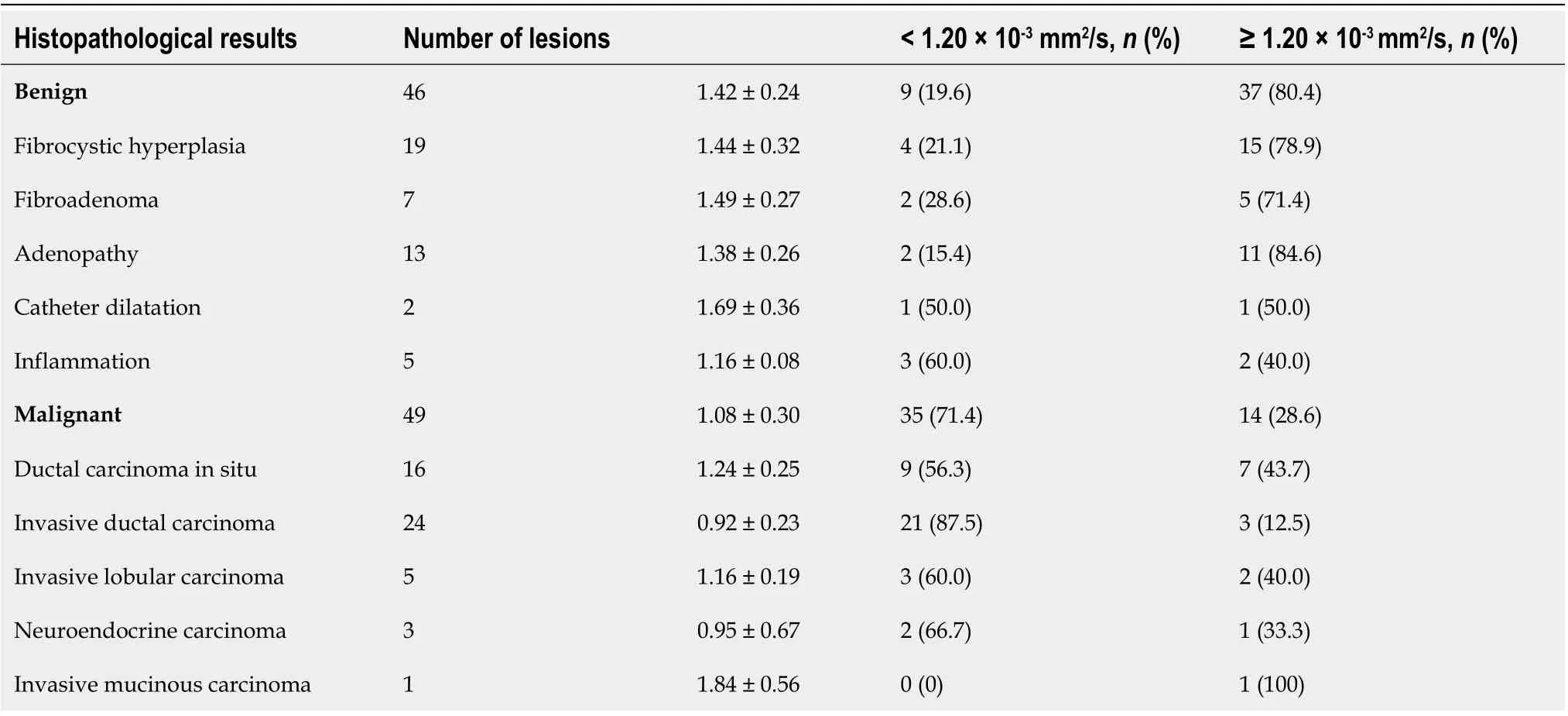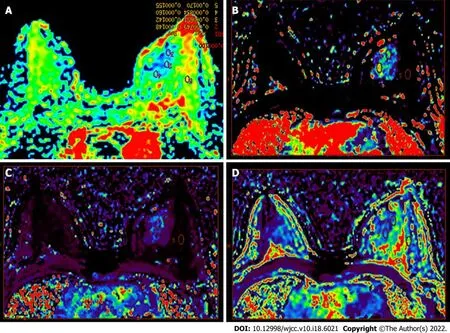Value of magnetic resonance diffusion combined with perfusion imaging techniques for diagnosing potentially malignant breast lesions
2022-06-27HuiZhangXinYiZhangYongWang
lNTRODUCTlON
Breast cancer is one of the most common malignant tumors threatening women[1]. In recent years, the incidence of breast cancer has increased year by year, topping all types of cancer in Chinese women[2].Magnetic resonance imaging (MRI) has become an essential examination method to diagnose breast lesions due to the avoidance of ionizing radiation, high soft-tissue resolution, multi-parameter imaging,multi-sequence imaging, and high sensitivity[3,4]. Nevertheless, the specificity of MRI in detecting breast is relatively low, leading to many false-positive results and high rates of re-examination or biopsy[3,4].
Novel functional MRI techniques, including diffusion-weighted imaging (DWI), perfusion-weighted imaging (PWI), and other non-invasive detection methods, have enabled the detection of pathological conditions of tissues to reach on a molecular-level, as well as the detection of functional status and change in mechanisms of organs, tissues, and cells[5]. DWI is considered the most effective modality for malignant tumor screening and therapeutic effect assessment for breast cancer[6-9]. PWI can be applied in detecting blood perfusion in tissues, where the perfusion imaging pattern is closely related to the density of newly-generated microvessels in tumors[10,11]. Nevertheless, these techniques have not been widely validated in clinical practice since they mainly act as auxiliary roles for assessing suspicious lesions[8,12,13]. DWI can also monitor the treatment response to neoadjuvant chemotherapy[14] and help to determine the subtypes of breast cancer[15].
According to the MRI breast imaging reporting and data system (BI-RADS) (5edition), potentially malignant breast lesions are classified as the 4category (BI-RADS 4) with a wide variation with regard to the risk of malignancy, from 2% to 95%[16]. BI-RADS 4 lesions could be anything from benign to malignant, resulting in the difficulties for clinicians to distinguish between them[17-20].
Therefore, the present study aimed to investigate the diagnostic efficiency of the apparent diffusion coefficient (ADC) combined with PWI in determining the nature of lesions categorized as BI-RADS 4.The results help to decide the exact nature of breast lesions before the patients undergo biopsy.
MATERlALS AND METHODS
Study design and patients
智慧课堂作为新型的教学模式和教学手段,以培养具有高智能和创造力的素质型、技能型人才为目标,依赖于数据挖掘、虚拟现实、人工智能分析等技术,实施学情诊断分析和资源智能推送,开展“云+端”学习活动与支持服务,进行学习过程记录与多元智能评价的新型教学模式。[1]本研究依托安徽省级质量工程智慧课堂试点项目,开展了基于超星学习通的智慧课堂研究和实践,应用于高职高专汽车类“汽车装饰与美容”课程的教学改革中,探索适应社会和企业需求的新型课程教学模式和人才培养手段。
The inclusion criteria were: (1) Age over 20 years old; (2) BI-RADS 4 based on mammography only;(3) Lesion > 5.0 mm; (4) The MRI examination of all lesions was completed before needle biopsy; and (5)The MRI examination included DWI and dynamic contrast enhancement imaging (DCE-MRI) in addition to the conventional plain scans. The exclusion criteria were: (1) Received neoadjuvant chemotherapy which might affect the MRI readings[14]; or (2) Clinical or pathological T4 lesion.
应该说这是一种非常合乎情理的推理,是一种常规思维。从多种结果的观察与比较中总结出规律,并形成结论。再通过中间这条线的变化,从侧面的例子进一步来说明这个结论的正确性,结论似乎已非常完美,这也达到了题目事先设计的要求,即本题解答过程的第二个阶段让学生形成一个统一的结论。
MRI acquisition
All study participants, or their legal guardian, provided informed written consent prior to study enrollment.
MRI analysis
The collected data were transmitted to the General Electric Assistant Diagnostic Workstation 4.6, and the image data were analyzed. Then two radiologists with more than 5 years of experience in breast lesion diagnosis provided an independent analysis and assessment without knowing the clinical and pathological results. A consensus was reached through discussion in case of any inconsistencies between them. Regions with enhancements in DCE-MRI sequence and high signal intensity in the DWI sequence were considered to be lesions. After obtaining the ADC map by post-processing, the ADC values were measured by manually placing the elliptic in the lesion area, and covering at least four minimum pixels, with the average value based on three measurements. Meanwhile, the volume transfer constant (K), rate constant (K), and extravascular extracellular volume fraction (V) in this region were measured (Figure 2).
BI-RADS 4 breast lesions at mammography only appeared a wide range of risk of being malignant (2%-96%)[17-20]. DWI and PWI could help discriminate benign from malignant lesions[6,10,11], but thosetechniques are mainly considered as accessory to standard imaging modalities[12]. Therefore, this study aimed to evaluate the efficiency of DWI and PWI in diagnosing breast lesions categorized as BI-RADS 4 at mammography. The results suggested that DWI, combined with PWI, might possibly distinguish between benign and malignant BI-RADS 4 breast lesions at mammography.
Pathological features
The lesion samples gained from needle biopsy were sent to the Department of Pathology at the Hospital to obtain the pathological results. The lesions were divided into benign and malignant groups according to the classification of histopathological results. The benign group included non-hyperplasic,hyperplasic, and atypical hyperplasic lesions. The malignant group included ductal carcinoma in situ and any type of invasive carcinoma[21]. For samples with mixed pathological characteristics, the more severe lesion prevailed (Figure 3). Surgical resection was performed for all patients whose pre-surgical needle biopsy results demonstrated either malignant lesions or atypical lesions.
The study was reviewed and approved by the First Hospital of Hebei Medical University. The need for individual informed consent was waived by the committee.
Statistical analysis
All data were analyzed using SPSS Version 18.0 (IBM, Armonk, NY, United States). Continuous data were presented as means ± SD or medians (range), according to the results of the Kolmogorov-Smirnov test for normal distribution, and analyzed using the Student-test or the Mann-Whitney U-test, as appropriate. Categorical data were presented as numbers (percentages) and analyzed using the chisquare test or Fisher’s exact test. Differences with< 0.05 were considered statistically significant.
RESULTS
Characteristics of the patients and lesions

This study included 95 breast lesions in 83 female patients, of which 36 patients were in the benign group, and 47 patients were in the malignant group. All women were Chinese Han. There were no statistically significant differences between the benign and malignant groups in terms of age, family history, history of benign breast disease, history of marriage, history of delivery, long-term use of exogenous estrogen, alcohol abuse, and age of menarche, but there was a statistically significant difference between the groups in terms of the age of menopause (= 0.021) (Table 1). As for the 95 lesions detected, 46 (48.4%) lesions were in the benign group, and 49 (51.6%) lesions were in the malignant group. The average size of the lesions was 2.2 cm (0.6-5.8 cm); the lesions were larger in the malignant group than in the benign group (median, 2.4 cm1.5 cm,= 0.007) (Table 2).
在穿越高铁桥梁桩基期间,建立足够的土仓压力平衡刀盘前端水土压力,以保证掌子面稳定,利用5个土仓压力传感器数据综合控制土压,上部土压控制在0.17MPa;将刀盘转速控制在1.4r/min,以减小掘进对周边土体和桥梁桩基的扰动;掘进推力控制在11 000kN,掘进速度控制在20~30mm/min[2]。
Perfusion parameters
Table 2 shows that the Kand Kvalues were both larger in the malignant group compared with the benign group (both< 0.001), but there were no significant statistical differences regarding V(=0.866).
Diffusion parameters
The ADC values in the parenchyma and lesion area of the normal mammary gland were 1.82 ± 0.22 ×10mm/s and 1.24 ± 0.16 × 10mm/s, respectively (= 0.021). The mean ADC value of the malignant group was 1.09 ± 0.23 × 10mm/s, which was lower than that of the benign group (1.42 ± 0.68 × 10mm/s) (= 0.016). Based on the literature[22], an ADC value of 1.20 × 10mm/s was used as the threshold for malignant lesions. Lesions with an ADC value lower than the threshold were considered malignant lesions, and those with an ADC value higher than the threshold were considered benign lesions(Table 3).
Diagnostic efficacy of DWI and PWI
We evaluated the diagnostic efficiency of PWI and DWI and combined examination techniques compared to the pathological results. The sensitivity and specificity of combined PWI and DWI were higher than those of PWI or DWI alone. The accuracy of combining the two test methods in predicting pathological results was also significantly higher than that predicted by PWI or DWI alone (Table 4).
DlSCUSSlON
关于山水画的研究,成果丰硕,角度众多,有的从艺术社会学角度来分析山水画风格与社会深度之间的关系;有从形式转变角度来研究艺术家及艺术流派的风格。尚辉以为,“从自然科学的角度入手,不仅在方法论上将自然科学与社会科学有机联系起来,而且在一定程度上论证了中国山水画风格及流派的形成与自然山水视觉效应在内的辩证统一联系”①。韩长生认为,“通过山川地理、地貌考察联系比照,为范宽《谿山行旅图》找到了‘写山真骨’之依据”②。从这一角度出发分析李唐的作品《万壑松风图》,可以发现山水画皴法与自然地貌之间确实有特定的联系,皴法是认识与表现物象的形的一种技法,也是区分不同时期、不同画派之间绘画风格的重要因素之一。


To improve the accuracy of combining PWI and DWI in predicting pathological results.
Many studies have been conducted on the threshold point of the ADC value used to distinguish benign lesions from malignant ones, and their conclusions differ[28,30,31]. By referring to the methods used in the literature[22] and diagnostic tests, the present study used 1.20 × 10mm/s as the critical ADC value to distinguish benign lesions from malignant ones in the DWI examination of breast lesions.The accuracy obtained by comparison with the pathological results was approximately 73%. Using a relatively high ADC value as the critical point can effectively avoid over-diagnosis of BI-RADS 4 Lesionsat mammography. Except for 5.5% of the cases in this study, which were mucinous carcinomas (with an ADC value of 2.20 × 10mm/s), all lesions with ADC values > 1.74 × 10mm/s were nonmalignant, as indicated by the final pathological results. This critical point is close to the average of the critical values ranging from 1.60-1.81 × 10mm/s, as reported by previous studies[22,28,30]. Ren[31] showed that the ADC values could be used to evaluate breast lesions’ malignancy. Spick[32] also stated that DWI might partially eliminate the need for MRI-guided biopsies. They revealed that when the ADC value of 1.58 × 10mm/s was used as the threshold, no false-negative occurred.


PWI is an imaging method that can clearly display microvessel density[33] and reflect the neovascularization of tumors, which is a necessary condition for tumor growth, progression, and metastasis[7,8,12,34]. The hemodynamic information that it provides has enabled quantitative analysis. The parameters include K(which refers to the rate of the contrast agent diffusing from the inside to the outside of the blood vessel), K(which refers to the rate of the contrast agent in the extravascular tissue space returning to the blood vessel after diffusing for a period of time), and V(which is the volumetric ratio of the extravascular extracellular space to the total voxel). These parameters are able to quantitatively evaluate blood perfusion in the diseased tissue[7,35], thereby enabling quantitative and differential diagnoses of lesions. In the present study, there was a significant increase in the number of blood vessels throughout the breast in sequence of PWI. The reason may be that tumor blood vessels face smaller growth resistance, and the high metabolism level of tumors gradually stimulates the regeneration of blood vessels throughout the breast. In addition, studies have shown that breast cancer with multifocal lesions, large masses, and axillary lymph node metastases have also exhibited pronounced neovascularization throughout the breast, suggesting a poor prognosis[36]. It can thus be inferred that the significant increase in the number of new blood vessels in the breast with cancerous lesions will suggest the progressive growth of malignant lesions and intramammary metastasis.


Conventional MRI scanning techniques combined with DWI and PWI can provide information on the internal structure of the breast[27], reflect the pathological characteristics of the tissue more accurately,and improve the diagnostic accuracy for breast lesions by measuring ADC values and quantitative parameters of PWI[7]. This method achieves the transition from qualitative diagnosis to quantitative diagnosis, thereby associating BI-RADS 4 lesions with corresponding histopathological grades. By using a DWI sequence combined with the quantitative parameters of PWI, a pathological classification of potentially malignant lesions, which were diagnosed as BI-RADS 4 lesions by mammography, was performed in this study to improve the accuracy of imaging diagnosis and provide different clinical recommendations. The present study proved that the sensitivity and specificity of DWI combined with PWI were higher than that of DWI and PWI alone. Nevertheless, additional studies are necessary to further confirm those results. Follow-up observations with imaging methods should be performed for those diagnosed with benign lesions, and needle biopsies should be performed, if necessary, for those diagnosed as malignant lesions.
This retrospective study included patients who underwent breast MRI examination, including symptomatic patients presenting to clinic and patients detected abnormalities in regular screening,between May 2017 and May 2019 at the Department of Radiology of Hospital. The diagnostic criteria were the 5edition of MRI BI-RADS[16].
This study has limitations. Firstly, the purpose of this study was to group BI-RADS 4 lesions at mammography based on their histological features by dividing them into two groups. Including atypical hyperplasic lesions in the benign group may result in bias, and different histological subtypes are included in the same group. As a result, the ADC values of the group may vary greatly. Secondly,two radiologists independently evaluated the slides, but the concordance was not examined. Thirdly,ultrasound data were not available for many patients because the physicians decided not to perform it,the patient refused, or it was done at another hospital, and thus could not be analyzed. Fourthly, the sample size was small, and receiver operating characteristics and multivariable analyses could not be performed. Studies with larger sample size are necessary to determine the real diagnostic value of DWI combined for PWI and determine the adequate cutoff values for the different quantitative parameters.
现实主义为了解国际社会提供了真实的一面,但其更侧重于描述以国家间相互实力的对比为核心的层面,在这种无政府状态下,国家之间并非完全处于一种无政府状态下的混乱局势,各个国际组织、国际法会对主权国家间的行为进行相应的约束和遏制。但现实主义并未对国际关系中各国之间的合作与发展作出必要的解释和分析,建立在对现实主义批判基础之上的自由主义将从理论层面对这些问题进行相应的弥补和梳理。
CONCLUSlON
In conclusion, DWI, combined with PWI, might possibly help distinguish benign breast lesions from malignant ones and provide clear diagnostic results for patients with potentially malignant BI-RADS 4 lesions at mammography.
变量相关性分析表明,Sub与Own、Inst都是显著正相关,这在一定程度上可以说明政府补助对于社会投资者具有信号效应。Da与Own、Inst显著负相关,说明社会投资者对于会计信息质量较为重视。而Rem与Own、Inst无显著相关说明真实盈余管理较应计盈余管理更加隐蔽。另外,Roa、Lev与Own、Inst显著正相关说明社会投资者偏好绩效良好、有适当财务杠杆的企业。通过检验,变量的VIF值均小于2,多重共线性不会影响回归结果。
ARTlCLE HlGHLlGHTS

Research conclusions
The sensitivity and specificity of combined PWI and DWI were higher than those of PWI or DWI alone.DWI, combined with PWI, might possibly help distinguish benign breast lesions from malignant ones and provide clear diagnostic results for patients with potentially malignant BI-RADS 4 lesions at mammography.
由于林芝市特殊气候的影响,每年降雨量特别大,导致青稞倒伏以及发生锈病等农作物病虫害。对此,要采取切实可行的方法加以应对,如选育抗倒伏品种、适合林芝市的青稞优良品种,采用科学技术进行统防统治,做好病虫害的预测预报及防治指导工作,将灾害造成的损失降至最低。
Research perspectives
DWI has the advantages of short acquisition time, unnecessary for a paramagnetic contrast agent, and high sensitivity[23]. Therefore, DWI is widely used in the differential diagnosis of breast diseases, with the scanning parameters and diagnostic specificity being constantly optimized[24]. Among the new MRI techniques, DWI is considered a useful diagnostic method in differentiating benign from malignant lesions and assessing the therapeutic effect[2]. Studies showed that the ADC values of typical malignant tumors are lower than those of benign hyperplasic tissues and normal tissues[25,26]. This finding is partly attributable to the small extracellular space resulting from the high cell density of malignant tumors, which leads to the restricted diffusion of water molecules[25]. This complicated microscopic phenomenon can be partially converted into quantifiable parameters by measuring ADC values, which can thus be applied in distinguishing between different tissue sources[25,26]. In the present study, the mean ADC value of the observed lesion areas was lower than that of the normal breast tissues, and the mean ADC value of the malignant group was the lowest (except for necrotic areas). This finding is consistent with the results reported in previous studies[27,28]. Tsushima[29] found that DWI is extremely helpful for diagnosing breast cancer, which its sensitivity and specificity achieved 89% and 77%, respectively.
FOOTNOTES
Zhang H and Wang Y designed the experiment. Zhang XY implemented the experiment;Zhang H and Wang Y drafted the manuscript; Wang Y was responsible for the paper.
The study was reviewed and approved by the First Hospital of Hebei Medical University Institutional Review Board, No. 20210907.
All examinations were performed with the patients in the prone position. MRI was performed by a 1.5-T MRI scanner (Signa Excite HDxT; GE Healthcare, Waukesha, WI, United States) and a 3.0-T MRI scanner (GE Silent Discovery 750W; GE Healthcare, Waukesha, WI, United States) with an 8-channel phased-array bilateral breast coil. The scanning sequences and corresponding parameters were: (1)T2WI fat-suppressed fast spin-echo (FSE): Repetition time (TR) 6079 ms, echo time (TE) 85 ms, flip angle(FA) 111°, field-of-view (FOV) 36 × 36 mm, matrix size 320 × 256, number of excitation (NEX) 1.0, slice thickness (ST) 5.0 mm, scan time 2.44 s; (2) T1WI FSE: TR 697 ms, TE min full, FA 111°, FOV 36 × 36 mm, matrix size 320 × 256, NEX 1.0, ST 5.0 mm, scan time 1.05 s; (3) DWI: TR 2881.4 ms, TE minimum,FOV 36 × 36 mm, matrix size 128 × 128, ST 5.0 mm, b values 0-800 s/mm, scan time 2.01 s; and (4)T1WI dynamic perfusion: TR 5.5 ms, TE min full, FA 12°, FOV 34 × 34 mm, matrix size 160 × 150, ST 5.0 mm, 40 phase scanning, scan time 7.12 s (Figure 1). The contrast agent was gadopentetate dimeglumine(Jiangsu Hengrui Pharmaceutical Co., Ltd., China) and was administered at a dose of 0.2 mmol/kg with infusion rate of 3.0 mL/s. The intravenous injection of contrast agent began 30 s after the start of the scanning.
The authors have no conflicts of interest to disclose.
词之过片也可以另辟新境。如吕渭老《卜算子》中上阕写眉为愁锁,并用叠词“千千”修饰泪的何其多来言作者心中无限愁。下阕首句“莫唱短姻缘”,笔锋一转,另辟新境,把上阕的哀愁一扫而光,加之尾句“谁信”二字,又将上阕的愁情推开置去。
Technical appendix, statistical code, and dataset available from the corresponding author at wy80868@163.com. Participants gave informed consent for data sharing.
This article is an open-access article that was selected by an in-house editor and fully peer-reviewed by external reviewers. It is distributed in accordance with the Creative Commons Attribution NonCommercial (CC BYNC 4.0) license, which permits others to distribute, remix, adapt, build upon this work non-commercially, and license their derivative works on different terms, provided the original work is properly cited and the use is noncommercial. See: https://creativecommons.org/Licenses/by-nc/4.0/
张爱玲的短篇小说《色·戒》写于1950年,故事发生在抗战期间的上海,一群进步青年为刺杀汉奸特务头子易先生,派出最漂亮的女子王佳芝实施“美人计”。但在刺杀就要得手之际,剧情却戏剧性地发生逆转——王佳芝在老易为她买钻戒的过程中深受感动而改变初衷。
China
Hui Zhang 0000-0002-2971-5216; Xin-Yi Zhang 0000-0001-8705-4308; Yong Wang 0000-0001-5869-2044.
Fan JR
A
3) 基于反双曲正弦函数的自抗扰控制的参数为:R=10,a1=2,a2=2,b=5,β03=10,β1=5,β2=25,b0=0.002 3。
也被称作《DOTA2》,由《DOTA》的地图核心制作者Icerog(冰蛙)联手美国Valve公司研发的一款游戏,于2013年4月28日开始测试,发布中文名为“刀塔”,是该系列的第二部作品。
Fan JR
猜你喜欢
杂志排行
World Journal of Clinical Cases的其它文章
- Stem cells as an option for the treatment of COVID-19
- Development of clustered regularly interspaced short palindromic repeats/CRISPR-associated technology for potential clinical applications
- Prostate sclerosing adenopathy: A clinicopathological and immunohistochemical study of twelve patients
- Effectiveness and postoperative rehabilitation of one-stage combined anterior-posterior surgery for severe thoracolumbar fractures with spinal cord injury
- Construction and validation of a novel prediction system for detection of overall survival in lung cancer patients
- Identification of potential key molecules and signaling pathways for psoriasis based on weighted gene coexpression network analysis
